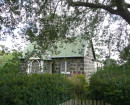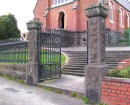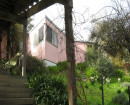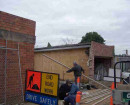LA MAMA THEATRE BUILDING
205-207 FARADAY STREET CARLTON, MELBOURNE CITY
-
Add to tour
You must log in to do that.
-
Share
-
Shortlist place
You must log in to do that.
- Download report
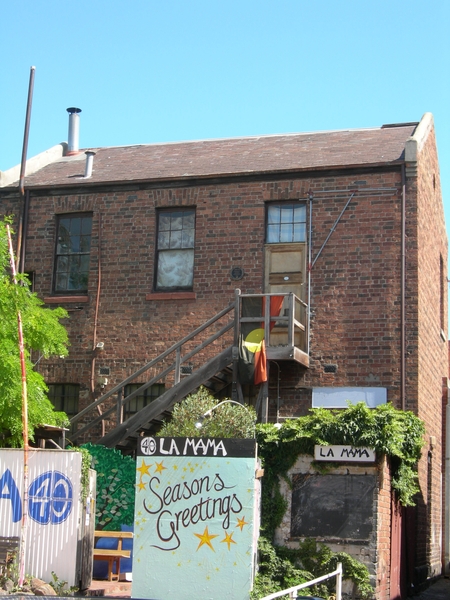












Statement of Significance
What is significant?
The simple two storey brick building now serving as La Mama Theatre was built as a printing works for AR Ford in 1883. Designed by Carlton architect George S Clarke, it faced a right-of-way off University Street, which is south of and parallel to Faraday Street. The land in front of the Theatre is currently used as a car park and affords a view of the Theatre from Faraday Street. After serving various industrial purposes it was leased in 1967 by Betty Burstall, teacher and theatre-lover, for use as a small theatre to nurture new Australian drama. Carlton's La Mama was inspired by and took the name of a small basement experimental theatre in New York established by alternative theatre legend, Ellen Stewart, in 1961. It aimed to provide a venue where artists could present new works without the worry of production costs.
La Mama's diminutive performance area is merely a space about five metres square. It is usually painted black, but can be altered to suit each performance. One corner contains a coffee bar where coffee is served before and after performances; adjacent is an open fireplace. The maximum audience La Mama can hold is fifty. Upstairs is the office/dressing room.
Twenty five new Australian plays were premiered at La Mama during its first two years. La Mama was initially funded by Betty Burstall but since 1971 the non-profit organization has received government sponsorship. Between fifty and sixty plays are commonly performed each year, attended by more than 20,000 people. From its beginning La Mama also fostered new works from composers, poets and filmmakers.
How is it significant?
La Mama Theatre is of historical, social and architectural significance to the state of Victoria.
Why is it significant?
The La Mama Theatre is historically important for its significant role in the development of Australian drama, being committed to diversity of artistic approach, innovation and the exploration of minority as well as general concerns. When initiated it provided a venue for the production of Australian plays at a time when traditional European theatre predominated and when performance of local productions was financially dangerous.
It has nurtured a host of internationally award winning Australian playwrights, directors and actors such as Jack Hibberd, David Williamson and John Romeril and given initial exposure to a large number of poets, musicians, performance artists and experimental film makers. It became influential in the commercial film industry by fostering and bringing together many talented low-budget film makers, writers and actors, who later entered the industry through working for professional film maker Tim Burstall, the husband of La Mama's founder Betty Burstall.
The La Mama Theatre is socially important in having challenged political and cultural life in Australia by laying bare the issues, myths and mores of society with Australian settings, narratives and most importantly, vernacular. It embarked on a crusade against Australian censorship laws and produced a number of shows specifically attempting to taunt local officials with explicit public performances which were 'rich, relevant and ribald'.
The La Mama Theatre is a significant cultural institution of contemporary Australian theatre and is symbolic of the cosmopolitan character of Carlton, which is recognised nationally.
The La Mama Theatre building is architecturally important as a representative example of the simple restrained brick structures commonplace in the inner suburbs in the second half of the nineteenth century. Its modest nature is intrinsic to the physical manifestation of the La Mama Theatre as an icon of contemporary Australian theatre. It is the only known theatre of its type in Victoria.
-
-
LA MAMA THEATRE BUILDING - Permit Exemptions
General Exemptions:General exemptions apply to all places and objects included in the Victorian Heritage Register (VHR). General exemptions have been designed to allow everyday activities, maintenance and changes to your property, which don’t harm its cultural heritage significance, to proceed without the need to obtain approvals under the Heritage Act 2017.Places of worship: In some circumstances, you can alter a place of worship to accommodate religious practices without a permit, but you must notify the Executive Director of Heritage Victoria before you start the works or activities at least 20 business days before the works or activities are to commence.Subdivision/consolidation: Permit exemptions exist for some subdivisions and consolidations. If the subdivision or consolidation is in accordance with a planning permit granted under Part 4 of the Planning and Environment Act 1987 and the application for the planning permit was referred to the Executive Director of Heritage Victoria as a determining referral authority, a permit is not required.Specific exemptions may also apply to your registered place or object. If applicable, these are listed below. Specific exemptions are tailored to the conservation and management needs of an individual registered place or object and set out works and activities that are exempt from the requirements of a permit. Specific exemptions prevail if they conflict with general exemptions. Find out more about heritage permit exemptions here.Specific Exemptions:General Conditions: 1. All exempted alterations are to be planned and carried out in a manner which prevents damage to the fabric of the registered place or object. General Conditions: 2. Should it become apparent during further inspection or the carrying out of alterations that original or previously hidden or inaccessible details of the place or object are revealed which relate to the significance of the place or object, then the exemption covering such alteration shall cease and the Executive Director shall be notified as soon as possible. General Conditions: 3. If there is a conservation policy and plan approved by the Executive Director, all works shall be in accordance with it. General Conditions: 4. Nothing in this declaration prevents the Executive Director from amending or rescinding all or any of the permit exemptions. General Conditions: 5. Nothing in this declaration exempts owners or their agents from the responsibility to seek relevant planning or building permits from the responsible authority where applicable. Exterior:
Minor repairs and maintenance which replaces like with like
Removal of extraneous items such as air conditioners, pipework, wiring, antennae etc. and making good
Installation or repair of damp-proofing by either injection or grouted pocket method. Interior:
All works to the interior spaces excepting structural alteration of the fabric of the walls, floors, ceilings, stairs, doors and windows.LA MAMA THEATRE BUILDING - Permit Exemption Policy
The significance of the place lies principally in the unchanged nature of the external fabric since the building has been used as a theatre, and the ongoing minor internal changes being made to the two internal spaces for the continuing use as a theatre. The exterior of the building should therefore be maintained in its current state and the view of it from Faraday Street should be preserved. Permit exemptions are framed so that the interior spaces can be continually altered as required for the place to operate as a theatre.
-
-
-
-
-
FORMER CARLTON AND UNITED BREWERY
 Victorian Heritage Register H0024
Victorian Heritage Register H0024 -
ROSAVILLE
 Victorian Heritage Register H0408
Victorian Heritage Register H0408 -
MEDLEY HALL
 Victorian Heritage Register H0409
Victorian Heritage Register H0409
-
'ELAINE'
 Boroondara City
Boroondara City -
-oonah
 Yarra City
Yarra City -
..eld House
 Yarra City
Yarra City
-
-
Notes See all notes






